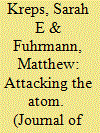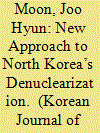| Srl | Item |
| 1 |
ID:
104330


|
|
|
|
|
| Publication |
2011.
|
| Summary/Abstract |
What are the consequences of military strikes against nuclear facilities? In particular, do they 'work' by delaying the target states ability to build the bomb? This article addresses these questions by conducting an analysis of 16 attacks against nuclear facilities from 1942 to 2007. We analyze strikes that occurred during peacetime and raids that took place in the context of an ongoing interstate war. The findings indicate that strikes are neither as uniformly fruitless as the skeptics would suggest, nor as productive as advocates have claimed. There is evidence that the peacetime attacks delayed the target's nuclear program, although the size of this effect is rather modest. The wartime cases were less successful, as attacks often missed their targets either due to operational failure or limited intelligence on the location of critical targets. In our concluding section we show that many of the conditions that were conducive to past success are not present in the contemporary Iran case. Overall, our findings reveal an interesting paradox. The historical cases that have successfully delayed proliferation are those when the attacking state struck well before a nuclear threat was imminent. Yet, this also happens to be when strikes are the least legitimate under international law, meaning that attacking under these conditions is most likely to elicit international censure.
|
|
|
|
|
|
|
|
|
|
|
|
|
|
|
|
| 2 |
ID:
167947


|
|
|
|
|
| Summary/Abstract |
Despite the Hanoi Summit between Donald Trump and Kim Jong Un, there has
been no positive sign that the North Korea nuclear problem is being resolved. To
advance the denuclearization negotiations, a new approach to denuclearization
must be considered, which needs to meet two objectives simultaneously: to relieve
North Korea’s concerns about its regime change and to practically eliminate its
nuclear capability to fabricate additional nuclear weapons and refurbish existing
nuclear weapons. The new approach should consider infrastructures that would
be indispensable in implementing North Korea’s denuclearization processes and
stopping any attempt to proliferate North Korea’s nuclear materials and technologies
amid denuclearization. Accordingly, this paper proposes a new roadmap whose
key concept is to first disable and, then, gradually but completely dismantle the
lynchpin nuclear facilities within 10 years. Here, lynchpin facilities are defined as
key facilities that are directly related to the production of nuclear materials or other
materials used when fabricating and refurbishing the key components of nuclear
weapons or which would have a fatal impact on maintaining North Korea’s nuclear
weapon program. Additionally, this roadmap addresses corresponding measures
for denuclearization activities. This roadmap consists of three sub-periods: the
lynchpin disablement period, verification and dismantling period, and manifest
threat removal period. This paper also identifies and incorporates into the roadmap
the supporting infrastructure and possible corresponding measures to accompany
the denuclearization steps.
|
|
|
|
|
|
|
|
|
|
|
|
|
|
|
|